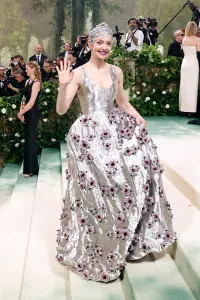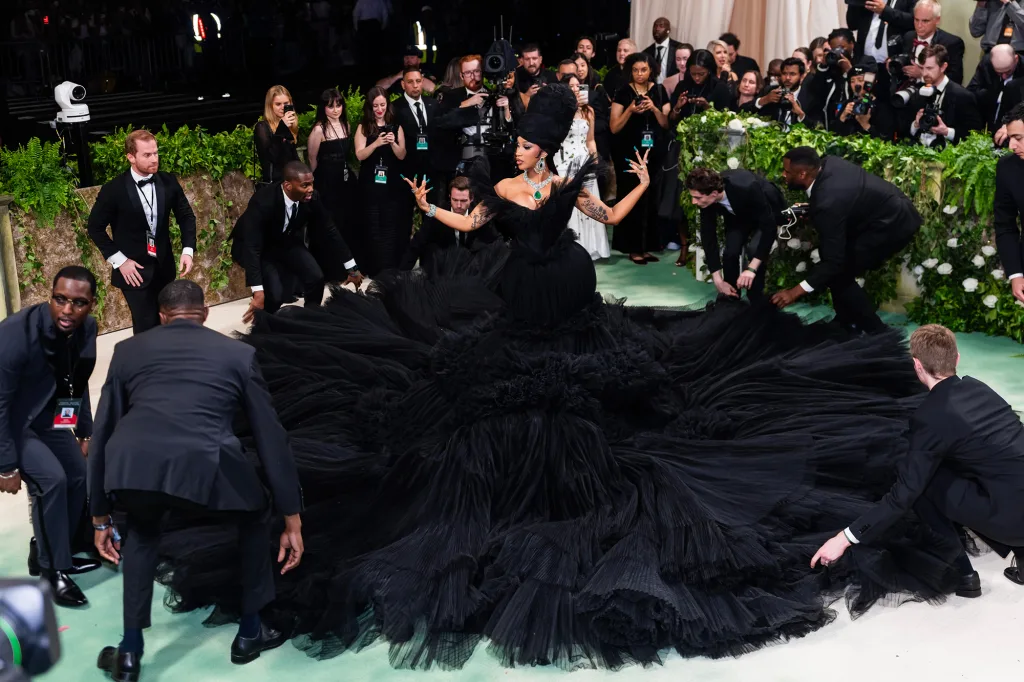The Met Gala celebrated flowers. It forgot about the environment
The Met Gala celebrated flowers. It forgot about the environment
This year’s theme, ‘The Garden of Time,’ should have been the perfect opportunity to embrace sustainable fashion. It wasn’t.
The Met Gala has historically disregarded sustainable fashion, despite its status as the industry’s biggest night. Designers compete to dress the most marquee names on the planet around a central theme chosen by Vogue, the event’s organizer.
Considering that tickets cost more than a down payment on a house, it was understandable why people were disgruntled last year when climate protesters temporarily delayed the entrance of several celebrities. And yet, this year’s dress code—The Garden of Time, to accompany the museum’s exhibition “Sleeping Beauties: Reawakening Fashion”—seemed like an opportunity for sustainable fashion to permeate the red carpet.
There was the usual sprinkle of celebrities who slipped on vintage gowns or vocalized requests for sustainable garments. But despite the interlocking themes of nature and the passage of time—ideas that seem handpicked to grapple with fashion’s role in climate change—most of the guests treated the gala as business as usual.
This seemed, perhaps, by design. Vogue itself failed to even nod at these issues: On the morning of the gala, the magazine posted a 1,200+ word explainer delving into various interpretations of the theme without once saying anything about the environment.
Sustainability expert and author Ashlee Piper wasn’t surprised. “So much of Vogue’s advertising revenue is centered around not only non-sustainable designers and goods, but designers and goods that actively exploit animals, workers, and ecosystems in the name of high fashion,” she says.
Inside the Met Gala’s theme

When Vogue touted “The Garden of Time,” it called it a “celebration of clothing and fashion so fragile that it can’t ever be worn again.” Ironically, this could be a climate activist’s worst nightmare. Instead of just advocating for celebrities to resurrect fashion lost in archives, Vogue could have considered the deeper meanings of J.G. Ballard’s dystopian short story of the same name, which inspired the theme. Instead, the greenest decision was airbrushing foliate on the off-white carpet.
The fashion world could have seen the theme about inevitable decay as a call to action rather than a tokenized motif. But as Kim Kardashian cinched her waist with a metal corset over a sheer dress with a lace train featuring leaves and floral accents and covered her arms with a cashmere cardigan, it was clear most attendees turned a blind eye to the issues plaguing the Earth. They instead simply adorned themselves with florals for spring.
League of Artisans cofounder Carry Somers thinks Vogue spectacularly missed the mark. They used Ballard as inspiration for a $75,000-per-ticket affair while skipping over the fact that he “delves into issues of inequality, highlighting the stark contrast between the opulent lifestyles enjoyed by the few and the struggles of everyone else.”
She says the author’s proverbial garden is fragile, its blooms poised to shatter, and so too are the reputations of the stars and designers. It may well have been in everyone’s best interests to avoid using the gowns as a platform to address climate change because it might have prompted savvy viewers to ask more questions about their business models.
Can the Met Gala ever be sustainable?

At the Garden of Time gala, as in years past, archival gowns were a way to satisfy both the desire for glamor as well as avoid fashion’s wasteful pitfalls. This year, Kendall Jenner wore a 1999 Givenchy couture piece that had been untouched for decades, worn only by a mannequin. Stylist Julia Gall thought this was a brilliant take on the “sleeping beauty” theme.
The night had other glimpses of sustainability, such as Charli XCX’s gown constructed from recycled cotton T-shirts. Doja Cat also paid tribute to cotton, turning a white cotton tee into a wet gown. The singer explained that her fashion choice was because the fabric is “the most-used flower,” and she called the white tee “timeless.” Fashion environmentalist Runa Ray says cotton itself is controversial due to its high water consumption and pollution output. But she found Doja Cat’s words symbolic because cotton “carries within itself myriad stories connected to the fashion industry”—both good and bad.
One of the night’s environmental champions was Amanda Seyfried. Ahead of the event, she told the New York Times that she felt “guilt and shame, literally every day” about the climate crisis and said she wouldn’t attend the gala unless there were solar panels on her head. While that didn’t literally happen, she did wear a metallic satin Prada gown adorned with flower appliqués made of fabric repurposed from the designer’s 2009 spring collection.
Ray emphasizes that deconstructing and repurposing garments is one way to improve the sustainability of a notoriously toxic industry. Cardi B’s look would theoretically be a perfect contender for that approach: The voluminous gown required a nine-person entourage to carry 10,000 feet of delicate organza, which turned her into a solar system. The feathery black gown has enough fabric to dress her entire party for a future event if she so wished.
Who’s responsible for change?

This celebrated excess makes it hard to see the Met Gala ever truly embracing sustainability. But Michelle Gabriel, graduate program director of sustainable fashion at GCNYC, believes it’s this sheer scale that would make it both symbolic and impactful if Wintour were to push for a change—both at the event and in the fashion industry more broadly.
“Inordinate water, chemicals, and raw materials are used to produce one gown, and significant emissions are produced at each stage of production from dyeing to processing to cutting and sewing,” Gabriel says. She jokes there was enough spandex on the red carpet to fill a landfill. In 2020, the textile sector was the third largest source of water degradation and land use.
There was also an unsettling way in which celebrities bragged about the amount of hours spent making their outfits. She says it’s hilarious that “Ashley Graham said the designer took 500 hours to make her dress” when it’s likely many of the gowns were made by underpaid women under intense pressure. Couture isn’t immune to the appalling labor conditions anywhere clothing is made around the world.
Ultimately, Gabriel believes sustainability in today’s fashion system is all but impossible, in large part because not enough people care about its detrimental impacts on our ecosystem. Her research reveals that the issue goes beyond altering consumer culture; it involves empowering Americans to recognize their civic responsibility and urging lawmakers to implement solutions.
Alicé Nascimento, campaigns director at New York Communities for Change, was part of the leadership that organized the climate protest at the Met Gala last year. She says they specifically targeted the gala because they believe in strategically going after and exposing the culprits—in this case, the people fueling the fashion industry and its disastrous environmental impacts. “A few billionaires have literally higher carbon footprints than entire countries; we’re talking places as big as France, Egypt, and Argentina,” she says.
Nascimento argues that the burden of saving the planet is often placed on the masses, but real change is unlikely without holding Wintour’s powerful party list accountable.
“Designers, fashion companies, and celebrities all have the ability, the means, and the resources to make [sustainable] choices,” Gabriel adds. “But they simply do not.”
(18)



